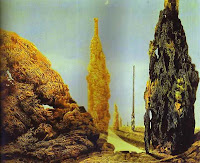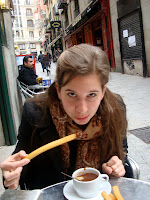My visit to Lagrimas de Eros (Tears of Eros), a visiting exhibit at the Museo Thyssen - Bornemisza, was definitely the highlight of my afternoon (and it put my knowledge from Professor Graham's Freudian-based English course to use)! The art demonstrated "the Classical issue of the intimate relationship between Eros and Thanatos, between sex drive and death instinct." The exhibit was divided into several sections including: the Birth of Venus, the Song of the Sirens, the Kiss, and San Sebastian. It confronted death, as both beautiful and terrifying, as it exists intertwined with love and seduction. The exhibit culminated with a series of multimedia projections that explored a mix of water and eroticism.
I particularly liked the combination of eroticism and submission in Dali's "Las Rosa Sangrantes" and the theme of bondage/mutual slavery in Warhol's "The Kiss." I learned a lot about San Sebastian's position as the gay icon (with his face of agony and ecstasy). I was also impressed with the juxtaposition of older works (paintings from 1899) next to current pieces (photographs from 2004).
After an overdose of sirens, nymphs, and mermaids, I headed to the permanent collection, which begins on the second floor. Here, in no particular order, are my top five favorites from the collection at the Museo Thyssen - Bornemisza:
1. Van Gogh, Les Vessenots
2. Lichtenstein, Woman in Bath
3. Ernst, Lone Tree and United Trees
4. Degas, Bailarinas Verdes
5. Mondrian, New York City 3

















































